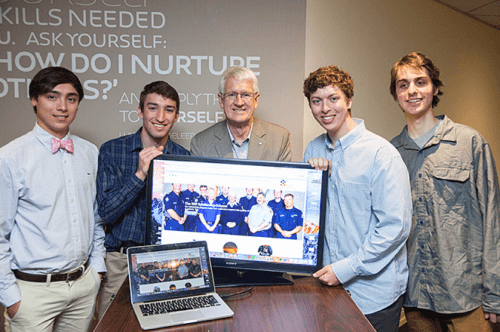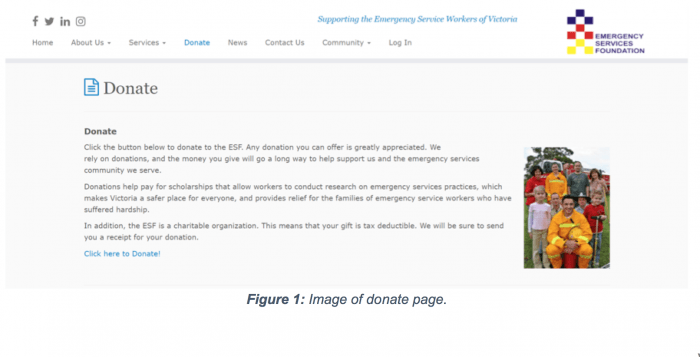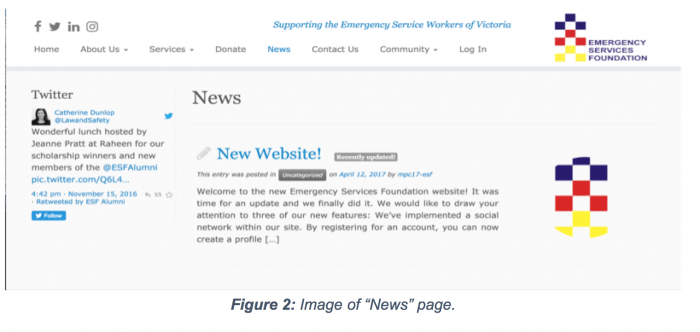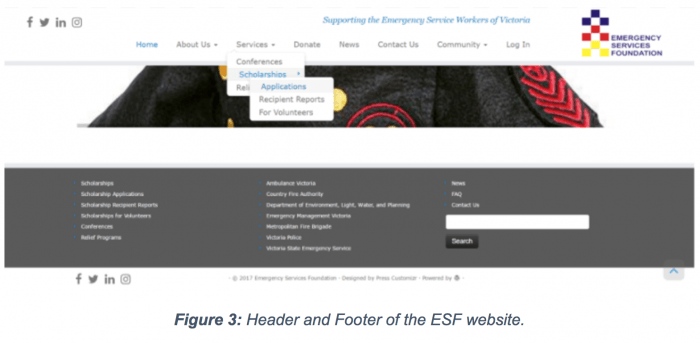Authors
Bryant Babel, Matthew Sanchy, Ryan Capozzi, Hayden Savage
Sponsor
Emergency Services Foundation
Advisors
Stephen M. McCauley, William R. Michalson
Term
March – May 2017
Abstract
The increasing pervasiveness of the Internet and social media has resulted in online marketing techniques and unprecedented organization-stakeholder communication. The goal for this project was to improve the stakeholder interactions for the Emergency Services Foundation (ESF), a nonprofit charitable organization that aids the emergency services community. We investigated best practices in online communication and the needs and experiences of emergency service workers. We created a new website and provided resources for the ESF to maintain improved communication and sustained success.
Executive Summary
Introduction and Background
The Emergency Services Foundation (ESF) is a nonprofit organization located in Victoria, Australia that provides financial aid to emergency service workers injured in the line of duty, annual emergency service conference events, and scholarship opportunities for emergency service workers interested in conducting research on improving the safety and effectiveness of their work. The ESF provides aid in the event of a large-scale disaster. Uniquely, the ESF does so by supporting emergency service workers, a safety net that did not exist in Victoria prior to its founding. The ESF was established following the 1983 Ash Wednesday bushfire disaster, the worst bushfire disaster in Victorian history at the time. The organization was officially founded in 1987 as a means of collecting and transferring a large sum of donations made after the disaster to emergency service workers impacted attending the bushfire.
The organization is currently lacking sufficient funds to provide large-scale support in the event of a major disaster. Additionally, the organization hopes to improve interaction with its constituency. The ESF would like to account for both of these goals through a redesign of its outdated website and improvement of social media practices. This project was intended to assist the Emergency Services Foundation improve stakeholder interaction by building a new, interactive web platform for the organization. We were tasked with also providing guidelines to ensure continued success on the website and social media. The goal of these efforts was to improve the organization’s outreach, stakeholder engagement, and fundraising capabilities.
Methodology
The four main objectives completed for this project were:
- Research best practices and strategies for maintaining an effective online presence.
- Assess the needs of the ESF and its key constituency groups.
- Create the ESF website.
- Compose a comprehensive guide for managing the ESF’s website and social media accounts, including a collection of media to serve as website and social media content with sustained maintenance in mind.
Prior to the project term, we researched various topics of interest in regards to website design, including best practices for website design and social media, utility of web analytics, and cyber security.
We considered ESF board members and past ESF Scholarship Awardees as our key stakeholders, as the board members had specific ideas and visions for the new website and social media. Scholarship Awardees heavily accessed the previous ESF website and would be able to offer insightful advice and opinions in regards to what the website should provide.
In order to assess the needs and opinions of these groups we conducted a variety of tests. We held informal discussions with board members in order to determine what initial features must be implemented on the website and what approaches should be taken on social media. A website survey was sent out to a contact list consisting of scholarship awardees and other members involved within the ESF in order to understand how the ESF website is utilized, as well as to determine internet and social media trends within the constituency.
Findings
Through these interactions with key stakeholders we determined major themes and features that should be acknowledged when developing the website and establishing appropriate social media criteria. The following is an outline of these results:
Analysis of Stakeholder Website and Internet Usage
The former ESF website generated little web traffic.
Based on survey results, it was found that stakeholders visited the website at most once a month and a majority visited the site either once a year or less than that. This information reinforces the need for a more interactive ESF website that encourages more frequent usage.
In regards to Appearance, Navigability, and Information/Content the website scored mostly “Satisfactory” or “Poor” ratings.
Overall the website rated at either average or below average in the measured categories, suggesting the website required widespread improvement.
ESF website pages are informative, however content and appearance are dated.
The previous ESF website posted information such as annual reports; however, though this information was useful, reports for the past two years have not been added. Additionally, scholarship awardee information appeared out of date to some respondents. Respondents offered input on ways to create a more appealing and interactive website in appearance and available content.
A majority of stakeholders spend less than 25% of their time on social media, with Facebook being the most popular, followed by Twitter, Instagram, and LinkedIn. Most prefer to be contacted via email.
These findings allowed us to determine which forms of social media and methods of communication are most effective in reaching out to stakeholders. However, at the same time it illustrates the lack of interaction the ESF has with its members and the potential benefits of improving online activity on social media.
Analysis of Stakeholder Themes on the ESF and Online Communication
The ESF requires improved fundraising capabilities.
Board members requested website donation capabilities that did not exist previously, including a donate button and a store feature where fundraising merchandise can be sold. Prior to this project, donations were accepted by direct transfers to the ESF bank account using information provided on the website. Additionally, the website must better illustrate the worthiness of the ESF mission in order to attract more donations, whether this be through captivating imagery or descriptions.
The ESF seeks increased interaction.
The ESF conferences have built a sense of camaraderie within emergency services. In a similar vein, the organization seeks to further increase community involvement through the website in the form of a social space. Providing more information on scholarships and better presenting the achievements of scholarship recipients will also improve interaction. This is the main appeal of the organization. Therefore, providing such information is valuable in communicating the state of the research and also provides model examples for potential scholarship applicants. The ESF may also benefit from increasing social media activity as this allows for improved two-way communication and interaction.
Search Engine Optimization (SEO) and web analytics should be included.
Suggested both through our background research and by the various stakeholders interviewed, including a web content manager, the ESF would benefit greatly from implementing SEO to their website and measuring its effectiveness with web analytics tools, such as Google Analytics.
Deliverables and Conclusion
Suggested both through our background research and by the various stakeholders interviewed, including a web content manager, the ESF would benefit greatly from implementing SEO to their website and measuring its effectiveness with web analytics tools, such as Google Analytics.
We provided three deliverables to the ESF at the conclusion of our project:
- A new website
- A Website and Social Media Guide
- A media collection
The website incorporated researched best practices, as well as recommendations and suggestions made by our key stakeholder group. Many features fulfilled an organizational need and also improved navigability, appearance, and information/content.
We improved fundraising capabilities through the addition of a donate link, as well as the incorporation of an online shop to sell fundraising merchandise. In addition, captivating images and descriptions were added to better illustrate the ESF’s mission. Figure 1 displays an image of the added donate page.
We improved website interaction through the creation of a member’s forum using BuddyPress. In addition, the new site includes web security features through WordPress and the Wordfence plugin. Social media links were added at the header and footer of the website and a Twitter feed was added to the sidebar. In addition, we included a “News” page where the ESF can post updates about itself and its member agencies. Figure 2 displays an image of the “News” page.
A robust gallery was added to the scholarship page. This gallery includes headshot photos, project briefs, full reports, photos taken while traveling, and video interviews of the project experience. Figure 3 displays the scholarship gallery.
In addition to these features we also incorporated striking image, links, and headlines to improve search engine optimization, as well as updated member agency links and information promoting cross-linking. Other features add for improved navigability, appearance, and information/content were a search bar and a Frequently-Asked-Questions page. Figure 4 displays the header and footer, which demonstrate some of these added features.
The Website and Social Media guide included comprehensive information on how to manage a WordPress site in order to allow for the organization to make easy edits and continually update the website. Best practices and various findings from our research were included that are beneficial for an organization seeking to improve online marketing techniques for websites and social media.
The media collection consisted of images provided by various member agencies consisting of operational and event photos. We recorded video interviews with scholarship awardees to provide an interactive, visual representation of the ESF scholarships. We also acquired images and website content from media managers of member agencies. Using this research a new website was created using the content management system (CMS) WordPress. We provided these resources for the ESF to use on their website and social media. In addition, we created a video compilation of interviews we conducted with scholarship recipients detailing their careers, application process, and project experience. The full interviews were also included. In order for an organization to benefit from its online platforms, constant maintenance and updates are necessary, which is why providing more resources for updates was a main deliverable.
Through our content collection and research we were able to create a more visually appealing and captivating website that may attract more individuals to the ESF cause, and help the ESF in achieving its new vision due to the changing environment in emergency services. The ESF seeks to attract the younger generation of emergency service workers and to begin attracting the general public as a necessary charity in the event of large-scale disaster. It also seeks to reinforce the mission of preventing widespread loss in the case of such of an event through innovative research in responder safety and emergency service practice. We believe the ESF will benefit greatly from improved website and social media practices, and that the guides and assets we have provided will serve as an excellent starting point for the ESF in achieving its goals of increased interaction with the emergency services community and the general public. In order to benefit from online stakeholder interaction, the ESF must maintain an active presence across their platforms. We hope to see the future success of the organization for the years to come and that the work we have done and the resources we have provided will be beneficial for the ESF. Specifically, we would like to see a more actively updated website and the formation of a larger and more dedicated community interacting with the ESF on their website and social media, hopefully resulting in an increase in donations to the organization.
Final Report
Improving Website and Stakeholder Interaction for the Emergency Services Foundation



